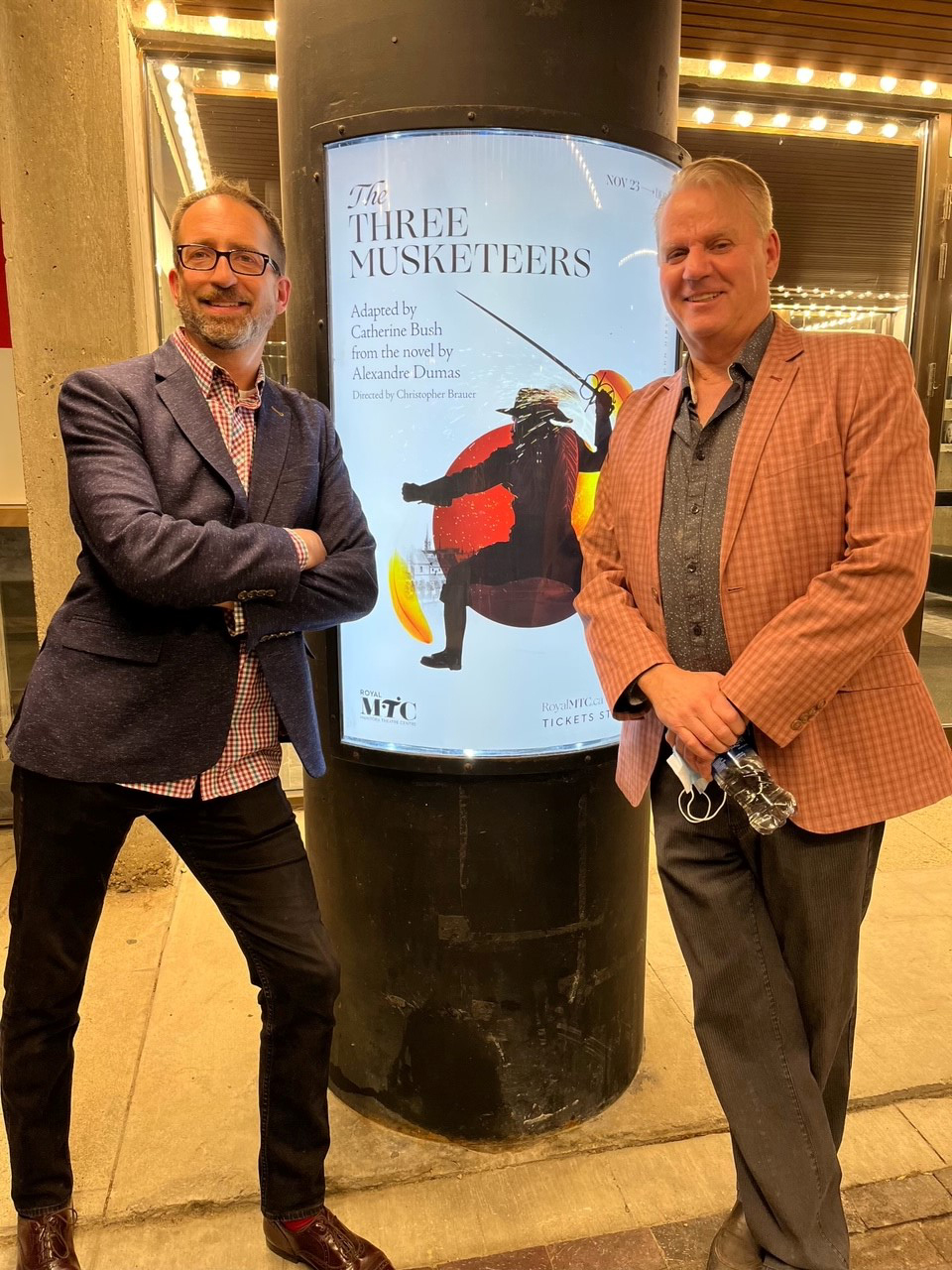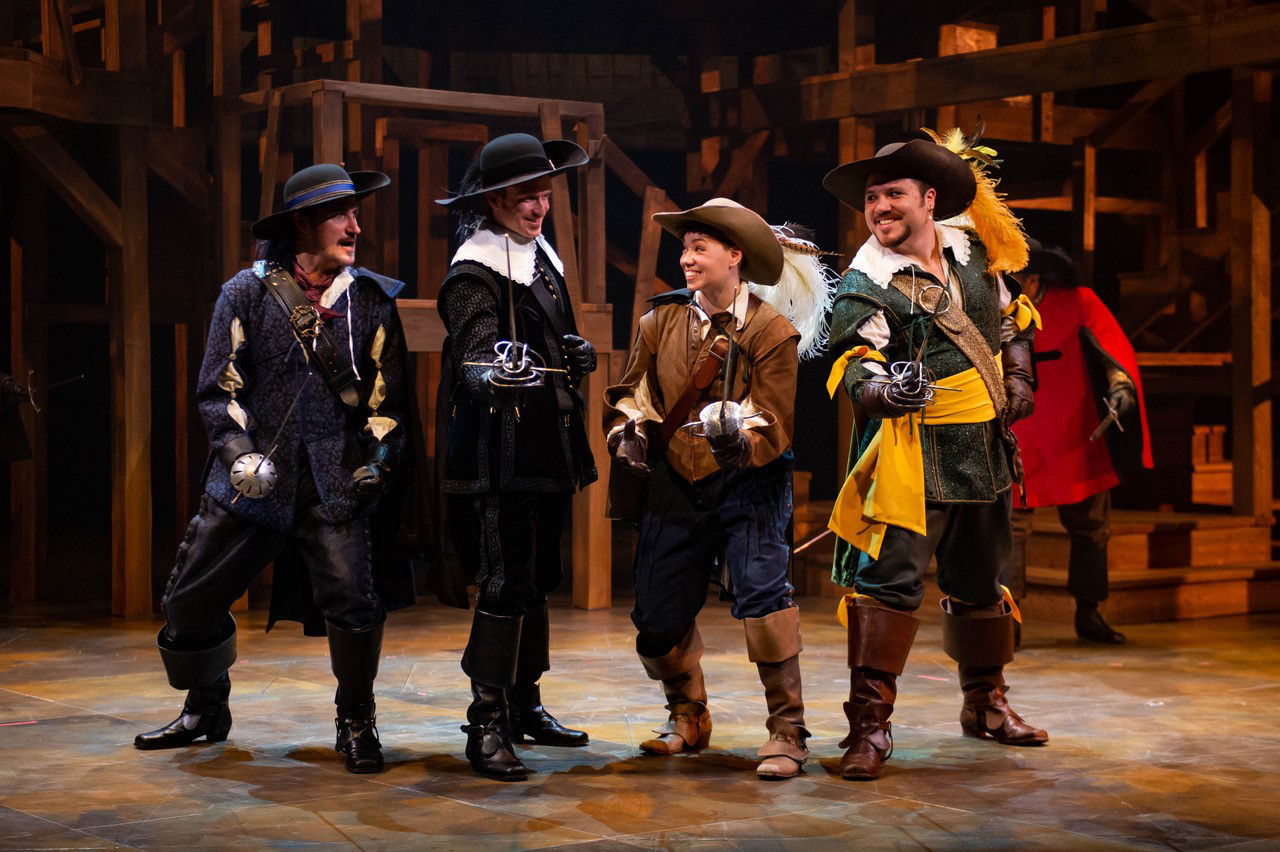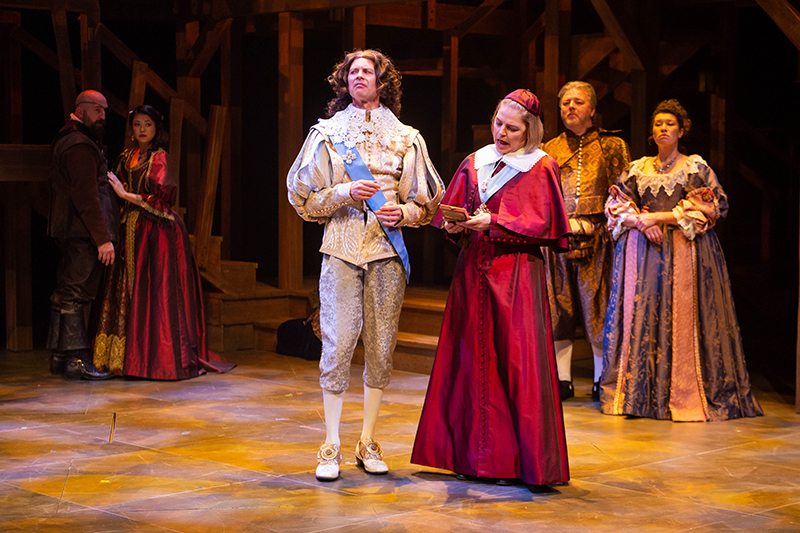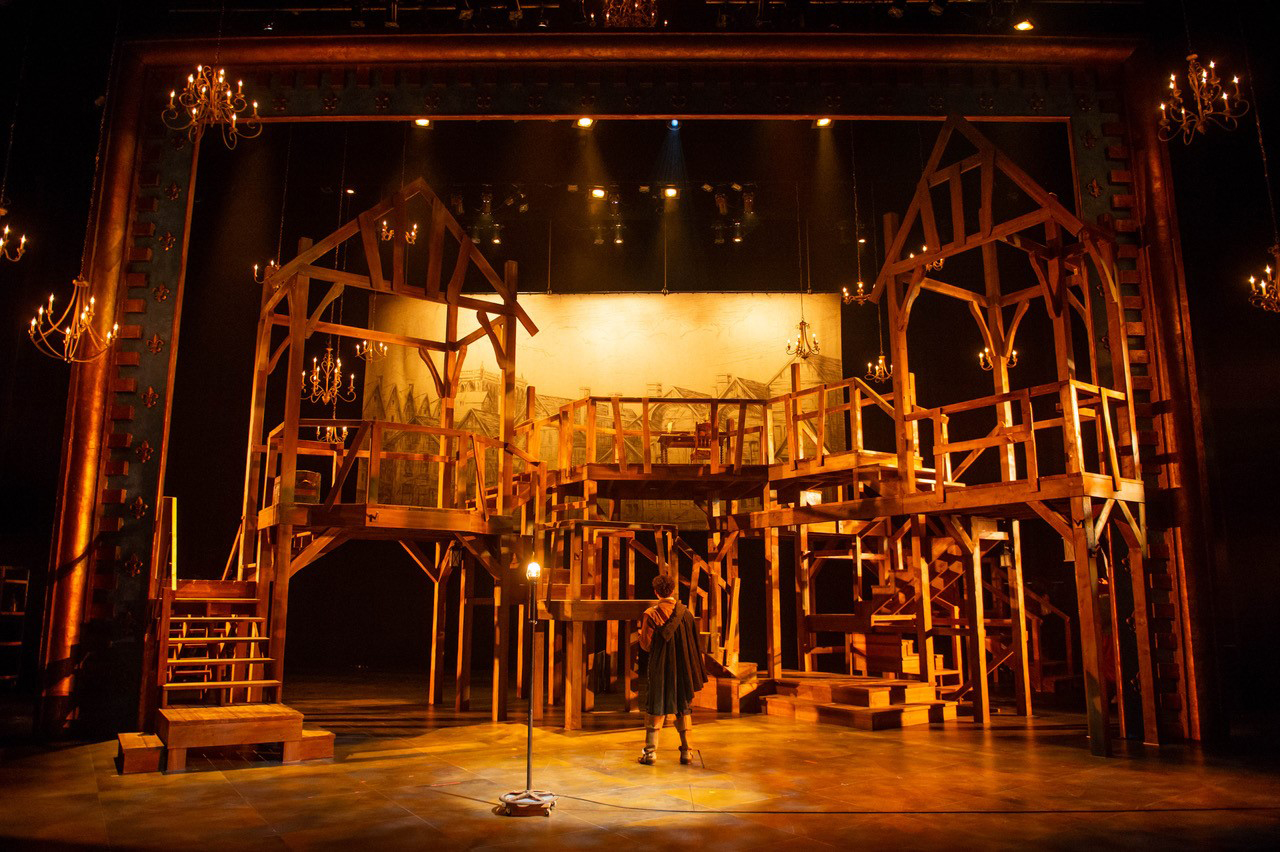THFM prof reflects on directing "The Three Musketeers" at RMTC (Part 1)
Wed. Apr. 5, 2023
Christopher Brauer is Department Chair and Associate Professor in UWinnipeg’s Department of Theatre and Film (THFM). Prof. Brauer’s creative work focuses on directing plays. Last fall, he directed The Three Musketeers (adapted by Catherine Bush from the novel by Alexandre Dumas) at the Royal Manitoba Theatre Centre (RMTC) Mainstage (November 23 to December 17, 2022).

Christopher Brauer (left), Director of "The Three Musketeers," says "It was always sort of a dream to do a show together," speaking of his longtime colleague and friend, Rick Skene, who was Fight Director for the production.
Photo credit: Dylan Hewlett; Set Design: Brian Perchaluk; Costume Design: Michelle Bohn; Lighting Design (and THFM CAS member): Scott Henderson
Recently, I spoke with Prof. Brauer about this, his first experience directing at the RMTC Mainstage. My summary of this conversation is in two parts. In Part 1, Brauer reflects on the role of director and directing The Three Musketeers in particular, starting at the beginning in 2019 when he accepted the offer to direct it. As it turns out, directing a production isn’t unlike chairing a large academic department that has lots of moving parts. Both require planning and organization (“endless lists”), decision-making, and excellent interpersonal and leadership skills. In Part 2, Brauer speaks to the distinctively UWinnipeg character there was in all aspects of the production, i.e., from the actors on stage, to directing and stage management, and to the production teams backstage, and how this reflects positively on the University of Winnipeg’s THFM program.
Part 1
Arts Matters: How do directors get selected for productions? Is it something you apply for?
Christopher Brauer: You build relationships because in the end what you’re trying to do is build trust. You do that by having a track record of production: you’re getting the financing together to do Fringe [Fest] shows, etc., while at the same time building relationships with more senior directors by assistant directing for them. RMTC has a mentoring program for assistant directors. For example, for Musketeers, Matthew Paris-Irvine, a grad of the [THFM] program, was funded by RMTC to assist and that for him becomes a step along the road to becoming a director.
Over the years, I’ve met with artistic directors and built friendly relationships – as a connection to the University and outside of the University. They get to know me, the kind of relationships I build, and they see my work. Then it becomes about offers – which isn’t to say you can’t bring them a “pitch” (an idea for a show) – but big picture they have to make an offer.
In 2019 Kelly Thornton, Artistic Director for RMTC, called me for Musketeers to see if I was interested and if I’d be available. Every show that I’ve done in Winnipeg has been the result of an offer.
AM: What are the considerations for the production company?
CB: The stakes for the theatre are high. A flop costs a lot of money. [Brauer checks an official “pull sheet.”] For Musketeers, the pull sheet allowed for a cast of 15 actors, with two actors from out-of-town. Initially, there were no understudies included, but because of COVID, we had three. The set was to be a unit set to represent various locations, rather than multiple pieces that move around, and with one fly operator only (someone who operates the rigging in the fly tower, raising and lowering scenery elements). And RMTC flagged that for Musketeers, there would be emphasis on the wardrobe.

According to Brauer, "RMTC flagged that for Musketeers, there would be emphasis on the wardrobe."
Photo credit: Dylan Hewlett; Set Design: Brian Perchaluk; Costume Design: Michelle Bohn; Lighting Design (and THFM CAS member): Scott Henderson
These are the considerations and the analysis that they’ll do and they’ll base their budgeting on that. And their budgeting is a mystery to me. The theatre works out the subscription revenue needed to support that and then they project how many single ticket sales they’d need. Even a successful show can operate at a loss, if it doesn’t have the sales. Fortunately, our show exceeded expectations.
If I come in and direct a show that flops, then that’s a big loss. It’s also a reputational loss for the director and for the theatre company. It can lead not just to the loss of single ticket sales, but might also affect subscriptions. The stakes are very high when the theatre makes this decision. You never forget that when you’re in there directing.
AM: How would a new THFM grad position themselves if they wanted to be a director?
CB: A new grad would need to start by “assisting like crazy” and doing their own Fringe shows, indie (independent) shows, and building a successful granting track record, so the arts councils get to know them. That really matters and that’s how the individual’s reputation gets built. Again, it’s still all about relationships. As a freelance director, you’re travelling the country and you’re trying to build relationships and your reputation. That’s a hard life.
AM: What does the role as director encompass?
Casting
CB: [Brauer brings up another document, “the cast list.”] The cast list outlines the different tracks (or roles) for each actor based on the auditions. For example, the line for “Actor 15” indicates the name of the actor and lists all 7 roles Actor 15 plays. For Musketeers, we reworked the cast list from 2019 to 2023 due to the availability of particular actors changing during that time and COVID. Where a line is mostly blank, there have been no changes to the actor we’ve cast since the beginning. The final cast list eventually includes all the possible permutations we’d had for the cast since 2019.
This was an unusually challenging casting process because of the pandemic and because there were lot of costumes in the show – more than 60. Casting can start before you know much about the show, so that’s tricky. I probably auditioned 100 people before I really knew what I was going to do with the show. My priorities were that I wanted to have gender parity in the cast, though the script is written for mostly male actors. And I wanted to have racial parity in the cast and ensure that half the cast was IBPOC.
Logistics
CB: A show is all about logistics, so it’s lists, endless lists. You have to become a real pro at Excel. It’s literally going through the show and listing:
- the kinds of fights and who is involved in the fights,
- the props indicated in the script,
- the weapons, and
- the character scene breakdowns.
[Brauer pulls up a character scene breakdown from Musketeers.] For each scene, or each subscene, this lists which characters are in that scene. You’re breaking that down because that’s going to tell you about “quick changes” (or costume changes that take place very quickly during the show). The costume designer and the wardrobe department will use this to make their quick-change list and from that they’ll make a “don/doff list” (which is a list of what costume pieces the actor “doffs” (removes) and then which pieces they “don” (put on)).
When you’re doing a show with four actors, one set, and one set of costumes, it’s all very simple. But when you are doing a show like this, so much of what you’re doing is just figuring out logistically how you can do the show and what is actually needed. Musketeers was particularly tricky; this show is usually done with a cast of 16 and I was given a budget for 15. That’s why I thought it would be fun if Eric Blais (THFM alumnus and instructor) played [the roles of] both Lord Buckingham and King Louis, which was all well and good, but then the quick changes!

In discussing casting for "The Three Musketeers," Brauer says, "Eric Blais (THFM alumnus and instructor), pictured here on the left, played [the roles of] both Lord Buckingham and King Louis."
Photo credit: Dylan Hewlett; Set Design: Brian Perchaluk; Costume Design: Michelle Bohn; Lighting Design (and THFM CAS member): Scott Henderson
Concept and design
CB: Directing involves dealing with logistics, but it’s also about concept. What is this play actually about? How are we going to represent that? What is it about in this time and place, i.e., post-pandemic?
[Brauer brings up another document]. I created a file of inspiration images to present that as a jumping-off point for design conversations. It outlines some of my thoughts. For example,
- I wanted to have “ghost light” (a single light is on rather than having the space completely dark) and a sense of really feeling the theatre space itself.
- I had some notes, e.g., “quick, fluid, and mercurial.”
- I’m coming up with a way of approaching the show, e.g., “the play never stops and the set and lights catch up with the action.”
- I wanted to convey the sense that we’re coming back post pandemic, gathering again, and telling a live story.
I was looking at images, such as textures (old Parisian textures); the set of Hamilton – there was something about the bridge structure that was interesting; and various sites in Paris, e.g., courtyards. I was thinking about costumes and was looking at a contemporary rock-and-roll influence on period costumes. Where there were portraits, that was interesting, e.g., Alexandre Dumas himself. I was interested in more contemporary hair with colour in it for the women.
Next, you’re working with set design, lighting design, sound design, projection and costumes – and this was a huge one for costumes.
Decision-making
CB: Because of how theatre is made in Canada, you’re making decisions long before the actors are ever in the space. For example, we might need to borrow things from other theatres, e.g., Stratford, and would have to do that well in advance. You need to decide all 50 of these things four months before we’re ever in rehearsal because it’s way cheaper to pull from other theatres than to build, and the economics of things drive decision-making processes.
When I went into rehearsal on Halloween day in 2022, the visuals were already locked down with some room for amendment, but very little, because as it was the crews had to work very fast just to get the whole thing done.
Once we had an initial design and an initial layout, the theatre technical director does a “sight line audit” of it. He plugs that design into Vectorworks, a 3D design program. They’ve already got the theatre in there and they basically just draw sight lines from the corner seats and the back balcony. They [point out], “You’ve got obstructed views from here, here, and here.” And we go back to the drawing board and make tweaks, and so it goes.
Every day is a day of decision making. It’s making choices and once you’ve made those choices – unless you change your mind very quickly – you can’t go back. Decisions become very high stakes very quickly.
Part of that decision-making is knowing who to trust and whether to trust. You might say, “I trust you to make these decisions so you don’t need to tell me until the end.” On the other hand, it’s important to know when you need to be really clear when every decision on [something] has to come from you.
So the director is the one who brings it all together?
CB: The director is the centre point of the production. In a lot of ways, they’re “the booster” for it. You’re the one trying to keep the vision clear in everybody’s head, keeping everybody communicating, keeping everybody civil – which isn’t always easy (it was on this show, but it isn’t always), making sure relationships are good, and making sure that “balls don’t drop.”
It’s not like sitting down and writing a novel where it’s just me and a blank page. Really my art is working with people and keeping those people moving in the same direction. It’s also about absorbing differences. I might see a certain thing a certain way, but if the Designer’s really going, “Yeah but it would be amazing if we did this . . . ”, then sometimes, it’s being prepared to let go some of my own things to bring some of their ideas on board, so everyone’s work is respected.
There are certainly situations where I’ve done shows where I’ve already had the design and [I say to the designer], “I need you to realize this [particular] design concept.” But in this case, I didn’t really know what I wanted, aside from a general feeling about it. I didn’t have a picture of the set, so Brian (Perchaluk, Set Designer) had carte blanche to create as he did, beautifully.

Of the set design, pictured above, Brauer says that "Brian (Perchaluk, Set Designer) had carte blanche to create as he did, beautifully."
Photo credit: Dylan Hewlett; Set Design: Brian Perchaluk; Costume Design: Michelle Bohn; Lighting Design (and THFM CAS member): Scott Henderson
That’s the job until you get into rehearsal. Then you’re 8 hours a day, 6 days per week in rehearsal. You’re in production meetings and visiting the departments. You’re popping into “the shop” (carpentry shop and prop shop) and into wardrobe – in part for morale, just to say “You guys are amazing!” but also to see where things are going. Actors are off into fittings and you’re sent pictures all the time. You’re trying to direct a scene, but you’re also trying to go, “That costume’s good, that costume’s bad.” And in this case, we had to manage COVID and had three understudies doing multiple tracks and the fights.
Managing the working environment
CB: You’re trying to do all that without creating antagonistic relationships. Conflict is fine. Creative conflict is fine, but it’s important to make sure that doesn’t spill into other kinds of conflict. Particularly now there is a great sensitivity to making sure your working environment is very respectful. I put a lot of emphasis on ensuring that there’s a very collegial, a highly respectful, workplace with clear lines of communication and lines of complaint, etc. because it can get gnarly and it can get gnarly fast.
The biggest problem with theatre is “opening night is opening night.” There’s no one budging that date. You’ve got 3½ weeks from the first day of rehearsal. It doesn’t matter how big your show is, or how many troubles you have, that’s opening night. It generates fear in everybody and everybody reacts to fear differently. And I have [that fear] too. My job is also about managing everybody’s fear, reassuring everyone that it’ll be fine, and making sure we’re working productively so we’ll really be fine.”
Lisa Michelle McLean
Office Manager and Program Officer
Faculty of Arts: Deans' Office
